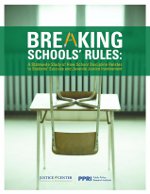School-to-Prison Pipeline: Why School Discipline is the Key (VIDEO) and What to Do About It
How do you reduce the number of kids going into the juvenile justice system? Overhaul school disciplinary policies.
Here’s a quick overview of research on the problem, a great video that puts a human face on the issue in Connecticut, and some things you can do.
 Just yesterday, the Council of State Governments Justice Center released Breaking Schools’ Rules: A Statewide Study of How School Discipline Relates to Students’ Success and Juvenile Justice Involvement. The report is based on a groundbreaking study of nearly 1 million secondary school students in Texas. (Researchers were able to control for over 80 different variables because they had individual-level records from schools and juvenile court for every single youth in the study.)
Just yesterday, the Council of State Governments Justice Center released Breaking Schools’ Rules: A Statewide Study of How School Discipline Relates to Students’ Success and Juvenile Justice Involvement. The report is based on a groundbreaking study of nearly 1 million secondary school students in Texas. (Researchers were able to control for over 80 different variables because they had individual-level records from schools and juvenile court for every single youth in the study.)
Though it’s methodologically very careful in its conclusions, it does show that:
nearly 60 percent of all students in the study were suspended or expelled between 7th and 12th grades;
African American students and children with “particular educational disabilities” were disproportionately affected — especially for infractions where administrators had discretion over what sanctions to apply; and
students who were suspended or expelled were more likely to end up in the juvenile justice system the following year.
But there’s grounds for hope, because researchers also found that:
suspension and expulsion rates varied widely beween schools, even among schools that were similar in terms of their students’ racial compositon or economic status.
This suggests that schools can handle behavior problems differently, and with fewer negative outcomes on the youth.
 This isn’t to say that teachers and school administrators should never suspend or expel youth. However, in the past 30 years, the rate at which students are suspended has nearly doubled in the last 30 years, and removing students from the classroom doesn’t actually make classrooms safer or help other students perform better. (My source is Suspended Education: Urban Middle Schools in Crisis, a report released last year by the Southern Poverty Law Center reviewing 30 years of data on the use of suspensions in middle schools. For an overview, see my post, School-to-Prison Pipeline: Middle School Suspensions Unfair and Ineffective.)
This isn’t to say that teachers and school administrators should never suspend or expel youth. However, in the past 30 years, the rate at which students are suspended has nearly doubled in the last 30 years, and removing students from the classroom doesn’t actually make classrooms safer or help other students perform better. (My source is Suspended Education: Urban Middle Schools in Crisis, a report released last year by the Southern Poverty Law Center reviewing 30 years of data on the use of suspensions in middle schools. For an overview, see my post, School-to-Prison Pipeline: Middle School Suspensions Unfair and Ineffective.)
Many states are beginning to address the problem. For instance, check out this great video from Connecticut, ”Education vs. Incarceration the Real Cost of Failing Our Kids.” Follow the link to see the full, hour-long program. (Hat tip to the Connecticut Juvenile Justice Alliance). The first segment is below:
The above story is reprinted with permission from Reclaiming Futures, a national initiative working to improve alcohol and drug treatment outcomes for youth in the juvenile justice system.
Newsfeed Archives
- November 2024
- October 2022
- June 2022
- May 2022
- February 2022
- January 2022
- December 2021
- November 2021
- August 2021
- July 2021
- May 2021
- April 2021
- February 2021
- January 2021
- December 2020
- October 2020
- August 2019
- August 2018
- May 2016
- September 2014
- April 2014
- December 2013
- April 2013
- August 2011
- July 2011
elsewhere
- An interview with Karlan Sick, Board President
- BOOKS CAN HELP INCARCERATED TEENS SUCCEED
- Books Through Bars
- Distribution to Underserved Communities Library Program
- Juvenile Justice Information Exchange
- Life Lessons Through Literacy for Incarcerated Teens
- Passages Academy Libraries
- Passages Academy Schools
- Read This
- What's Good in the Library?
- Women and Prison




